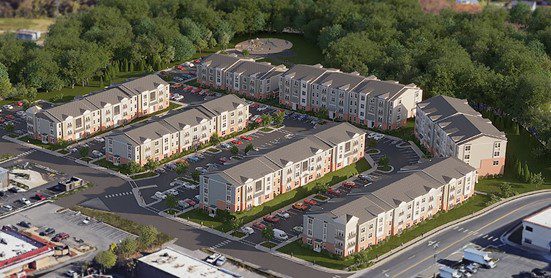Jefferson Plaza Apartments in Woodbridge, VA
The pandemic put a lot of stress on the retail sector, as health-conscious consumers turned to online shopping and started skipping trips to the local mall. As a result, malls and big box stores are struggling and sometimes failing. A worthwhile option for utilizing these unused retail footprints is large multifamily projects.
“Derelict” was the word used by local media to describe Jefferson Plaza, a shopping center in Woodbridge, VA that featured The Hub furniture store and a Ground Round restaurant.
In what may be par for the course for the shopping center, The Hub closed, and the Ground Round burned down. Subsequently, the property is set for demolishment and will become the site of 240 apartments in a $67.5 million affordable housing development by Standard Communities.
Notable features of this project include having financing with only three sources—eliminating gap funds—and overcoming the difficulties (easements, rezoning) of turning an old shopping center into affordable housing, as well as the proximity of the site to an underutilized park, a grocery store and numerous retail stores.
Feras Qumseya, chief development officer at Standard Communities, says the short capital stack was intentional. He notes the complexity of producing affordable housing and says he wants to simplify and streamline the process by reducing the reliance on subsidy sources, like counties and municipalities for additional financing.
“That’s by design. I focus on large bond deals I can put together that have as little gap financing as possible,” says Qumseya, who specializes in new construction for Standard. So, Jefferson Plaza Apartments’ sources consist of “tax-exempt debt, tax credit equity and deferred developer fee.”
Funding for Jefferson Plaza Apartments was secured through Virginia Housing as the lender and issuer of tax-exempt bonds. Freddie Mac provided the Low Income Housing Tax Credit equity through Hudson Housing Capital.
Jefferson Plaza Apartments “will comprise seven three-story buildings with 147 one-bedroom and 93 two-bedroom units. The community, being built on a 7.6-acre site of a dilapidated shopping center, is a transit-oriented development in the Route 1 Corridor within walking distance of the Woodbridge Virginia Railway Express station and close to I-95, with nearby shopping and restaurants,” according to Standard’s description.
“It’s a great location,” says Qumseya. “It’s near a grocery store, other retail amenities, restaurants and an underutilized park.”
The shopping center “has been an eyesore for the community for a long time,” adds Qumseya.
Not Zoned for Housing
With COVID and other factors, “a lot of shopping centers around the country have died. But they’re not zoned for housing, they’re zoned for retail,” he says. That creates a barrier to turning the shopping centers into something more useful for the community and creates opportunities for other developers to replicate.
“We approached the county (Prince William) and explained our vision,” Qumseya says. Standard’s goals and the county’s aligned well; the county wanted to mitigate the high housing costs in the community and was looking for ways to revitalize this corridor. Qumseya worked with county officials to convey the vision of redeveloping a dilapidated shopping center into workforce and affordable housing to serve our community heroes. He praised the county officers and staff by saying he couldn’t have gotten the deal done without their help.
Qumseya says he told officials, “We can turn the shopping center into great affordable and workforce housing.” The development, limited to 60 percent of Area Median Income, would help house “firefighters, teachers, police officers and retail workers. We can give them the opportunity to reside in high-quality, cost-efficient housing located near major thoroughfares, like Route 1 and I-95.”
County cooperation is key “in a high-interest rate atmosphere where putting together these projects is difficult.” It turns out “the county was supportive and said yes, they understood our vision,” he says.
Besides the necessity of rezoning, developing a shopping center “is complicated because it has lots of existing easements from prior uses that serve the retail infrastructure.” Parking, access and infrastructure easement (e.g., electric power, storm drainage, gas, etc.) are particular considerations.
“Some of these stores were owned by large corporations, so negotiating with them was cumbersome and complicated, and took a lot of effort. Once you add that layer to the project—and you know time costs money—it was something we simply weren’t willing to do if the county was not supportive,” he says.
The difficulties haven’t dissuaded Standard from doing more. “We are pursuing other deals,” says Qumseya. He says counties looking to increase the amount of housing they have should consider converting underutilized land for this purpose.
“This could be a test case for other counties to follow. Northern Virginia is a high-cost housing market. So, to be able to develop 240 affordable housing units that are all restricted at 60 percent AMI, and to negotiate it in a high-interest rate environment with no soft financing is a story in and of itself.”
Qumseya says he cannot identify any other developers who are working on redevelopments like this now. “It’s certainly not common in this environment.”
The idea of doing an adaptive reuse of existing unused shopping centers is more problematic, Qumseya notes. For one thing, most are only two or three stories high.
“You’re trying to take a box that doesn’t fit well with housing,” he says. “I couldn’t build the development I’m building now in an existing shopping center.”
Jefferson Plaza will feature 354 parking spaces for residents, a 3,000-square-foot club room, a co-working space, a fitness center, bike storage, a playground and recreational area, greenspace and a dog park. Residents will have direct access to an adjacent park.
Some of the relatively large amount of parking will be used for public access to the adjacent park, Qumseya says.
He has an arresting metaphor for the new development. Qumseya says it would be “the hole in the donut” connecting residents to the amenities that already exist in the neighborhood, including the park.
The effect on the local community? “Envision a dilapidated shopping center that is transformed into a middle-density housing community with lots of greenspace. The residents will frequent local retail stores, which will contribute to revitalization efforts and further investment in the community. You have restaurants that are coming to the area; you have retail, a grocery store and an underutilized park. We’re connecting all these people by developing this vibrant community.”
Construction on Jefferson Plaza Apartments has started and will continue for 16 months. The first building is expected to be online in approximately 12 months.
Approval from Local Officials
County and state housing officials praised the redevelopment.
“Revitalizing the Route 1 Corridor has been one of my top priorities since being elected as the Woodbridge district supervisor four years ago. Jefferson Plaza Apartments are a key part of that revitalization effort,” says Jefferson County supervisor Margaret Angela Franklin.
Janet Wiglesworth, interim CEO of Virginia Housing, says “Jefferson Plaza will provide an affordable, conveniently located, modern community for residents in Prince William County. It is a product of strong partnerships that have one goal in mind: to invest in the future of affordable housing in our communities.”
Case Study originally appeared in Tax Credit Advisor’s May 2024 issue.






